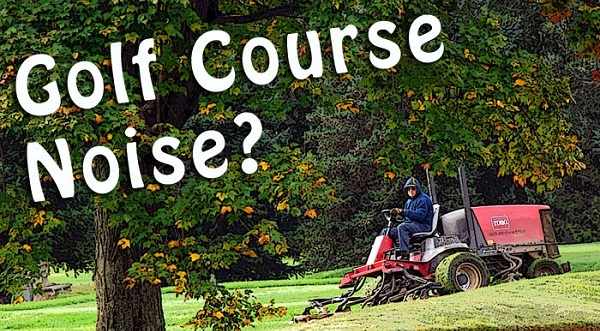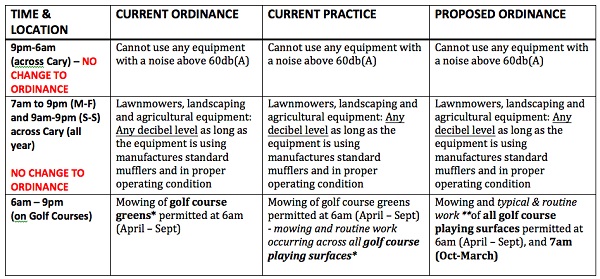Lori’s Blog: Golf Course Noise?
Cary, NC — There has been a lot of discussion at the Council table, online and in the papers regarding the proposal for an updated Golf Course Noise ordinance.
Noise Ordinance Proposal
Because the ordinance language can be a bit confusing, I took the liberty of making a spreadsheet to show what is changing and what is not.
I often do this sort of thing as I’m preparing to vote on a complex issue so that I can make sure that I understand all sides of the issue.
Considerations
First off, my mind is not yet made up here. I have concerns with changing an ordinance that will impact people whose homes and quality of life may be affected. Changing the rules in the middle of the game is not something that I take lightly.
But, at the same time, I look at the bigger issue and problem:
- There have been very few (no) complaints brought before two of the golf courses in the last few years (some in the last month or so, as this discussion began). Another golf course had a few complaints, but they were amicably settled.
- Many folks that purchased homes on the golf courses were aware of the potential noise issues when they bought or built their houses.
- I understand the economic vitality that golf courses bring to our community.
- Some of the issues with the ordinance are ambiguous and need to be codified more specifically so that everyone understands the rules.
So, having said all of that, here is a chart I put together, along with some explanations, that will guide me at the council table. I hope that it helps you understand the changes, the issues and the impacts. I’d be interested, as always, in your feedback.
The proposed ordinance language is here.
*Golf courses stipulate that “golf course greens” are defined by the USGA as all the grass on the course (i.e. fairways, tee boxes and putting surfaces). Cary has typically enforced the laymen’s interpretation that to “mow the greens” is defined as cutting the grass on the putting surface specifically. Anything outside of that was not allowed by ordinance.
This is one reason to codify the ordinance.
** Typical and routine work includes the mowing, blowing and raking of all of the course’s playing surfaces, using equipment operated with all the manufacturer’s standard mufflers and noise-reducing equipment in use and in proper operating condition. Typical and routine work does not include the use of chainsaws, chippers, shredders or equipment that is used on a sporadic, irregular basis.
Definitions & Explanations
What’s being changed?
- The proposed changes would allow golf courses to be prepared for play on all playing surfaces beginning at 6 am, 7 days/week April – September. The ordinance already allowed golf courses to mow the “golf course greens,” referring to the putting surfaces. However, the proposed updated language in the ordinance expands that to “all playing surfaces.” The golf course management stakeholders believe that that the “golf course greens” included the other playing surfaces, and they have been maintaining those surfaces in their current practices. As such, golf course management does not believe this is a change from their current practice, although it was not codified in our ordinance till now.
- The current ordinance specifies “mowing” – the updated ordinance specifies “mowing, blowing, and raking of the sand traps” as permissible activities for the golf courses to perform beginning at 6 am. Also added to this detail is that chain saws, chippers, shredders, etc are specifically NOT exempted by the “typical and routine work”, in the new ordinance. Therefore, that means that in order to use those, they would have to be under 60 decibels if used before 7 am during the week or 9 am on Saturday and Sunday. This matches the current general practice of the golf courses.
- Measurement of the 60db(A) has to be, and will continue to be, taken at or within the residential property line of the complainant. Added to this ordinance is that the sound measurement shall be averaged over 1 minute, and that it is a violation of the ordinance if it exceeds the average reading of 60db(A), or if any sound exceeds 62db(A) at any time during the measurement period.
- Also, staff has added a proposal for an additional exception to allow this same activity on the golf courses for the months of October – March. This proposal would allow work to begin at 7 am on Saturday and Sunday. The current ordinance would only allow that work on Saturday and Sunday at 9 am. Keep in mind that anyone across the Town of Cary can mow their lawn at 7 am Monday through Friday. This exception, to start at 7 am on Saturday and Sunday, would only apply to golf courses. We have been informed that this matches the current practice of the golf courses in the area.
What does 60db(A) sound like?
60db is equal to a conversation at three feet.
Anyone can do anything as long as it doesn’t exceed 60db. This is not a change. Note: this is a similar definition that is used by Industrial Noise Control, Inc. A chart by Industrial Noise Control can be found here for their specific wording.
What type of activity is being restricted?
There is no type of activity that is restricted from being performed at any time, rather, it is the level of noise created by that activity that is restricted. Said another way, anyone can cut grass at midnight, so long as they do not exceed 60 decibels at the property line of a person that complains about that midnight mowing. Anyone can do anything as long as it doesn’t exceed 60 db. This is not a change and has been allowed for years.
——————————————————————————————————————————-
From the blog of Lori Bush, At-Large Member of Cary Town Council. Photo by Penn State.





While it is the common standard for measuring noise in the U.S., there are problems with using db(A) for such measurements. The db(A) standard was developed using descrete sound frequencies across the measured spectrum to determine the equal-loudness countour a human ear. It was not intended to measure random noise. The db(A) filter also limits the signal level in the 5 to 8kHz area, where the human ear is more sensitive to random noise.
This is why most countries outside of the U.S. use the ITU-R 468 Noise Weighting Curve. It peaks almost 12dB higher in the area where the human ear is most sensitive to random noise. And extends the low frequency cut-off down to 10Hz from db(A)’s 100Hz cut-off. Giving a noise measurement much closer to what the human ear actually hears, versus the dB(A) filter which was intended to measure the ears response to descrete frequencies across a defined spectrum.
I think the Town will find there are less complaints if noise levels are measured using a meter with an ITU-R 468 weighting filter, rather than db(A).